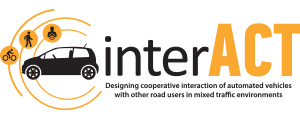The interACT project vision, objectives and technical approach
Project vision and objectives
Road traffic will never be fully automated – think, for example, of cyclists, pedestrians or other non-equipped vehicles. Understanding how to develop the right cooperation strategy between all road users, including Automated Vehicles, is of high priority, in order to ensure successful deployment and acceptance of such Automated Vehicles by all road users. Thus, the vision of the interACT project is to enable the safe integration of Automated Vehicles into mixed traffic environments by designing, implementing and evaluating solutions for safe, cooperative and expectation – conforming interaction of the Automated Vehicle with both its on-board user and other road users.
Project techical approach
To achieve the vision of the interACT project, the following technical approach was followed:
- Research on psychological models of interaction between different road users in mixed traffic situations by observing human-human interaction in real traffic. These are meant to help to design and select appropriate and safe interaction strategies for Automated Vehicles and evaluate the interACT solutions.
- Development of methods and sensor algorithms for assessing the intentions and predicting the future behavior of other traffic participants. These are used to improve the situation prediction of the Automated Vehicles.
- Development of a novel Cooperation and Communication Planning Unit. This unit enables the integrated and time-synchronised planning of Automated Vehicle’s behaviour and explicit HMI (on-board and external) and is the core intelligence of the Automated Vehicle.
- Research on a safety layer and fail-safe trajectory planning using formal verification methods to ensure safety in mixed traffic environments and reduce certification costs.
- Develop an integrated HMI and eHMI design for the interaction of the on-board user, the Automated vehicles, and other road users to develop expectation-conforming behaviour of the Automated Vehicles.
- Establish an evaluation methodology for assessing cooperation for studying interaction of road user with Automated Vehicles and user acceptance.

